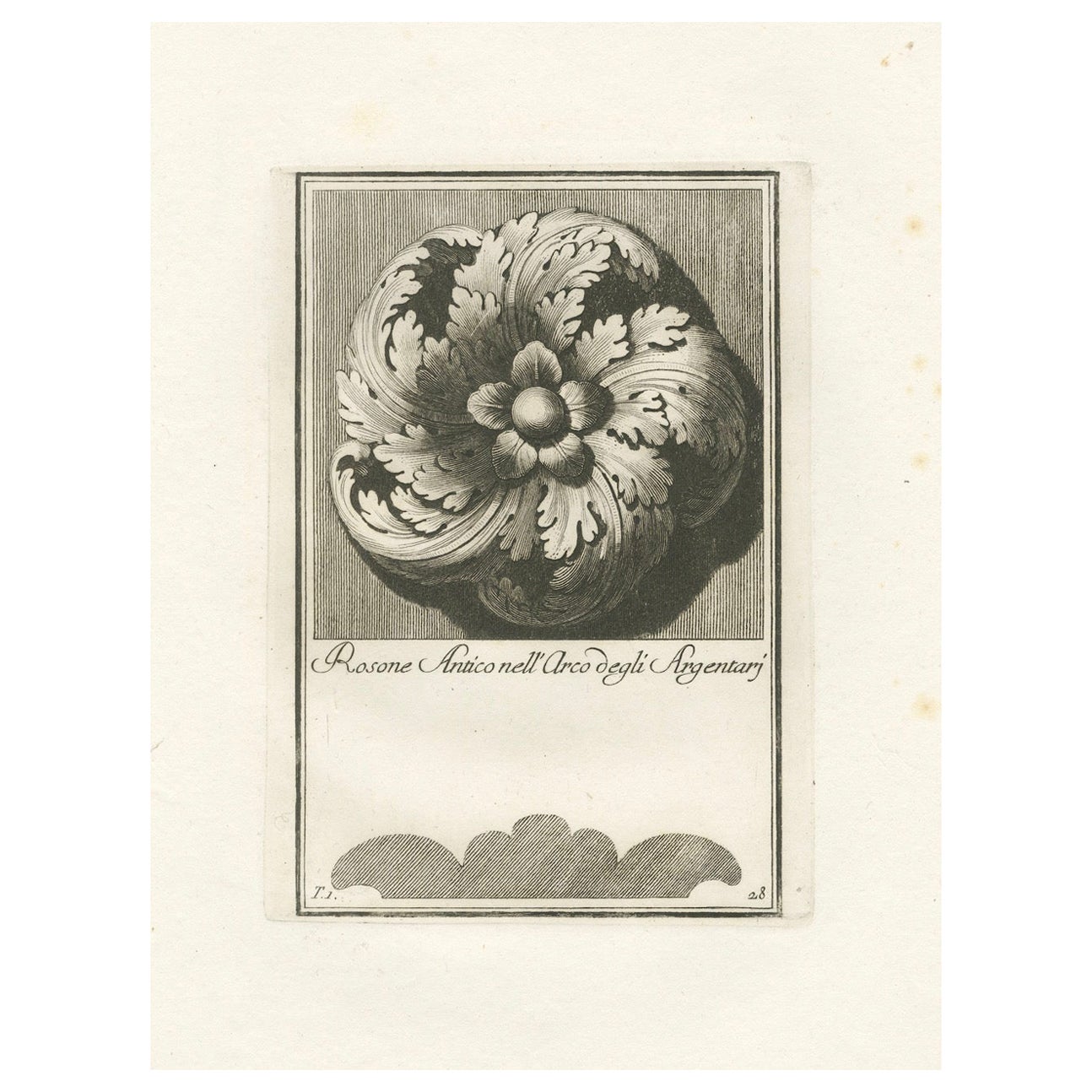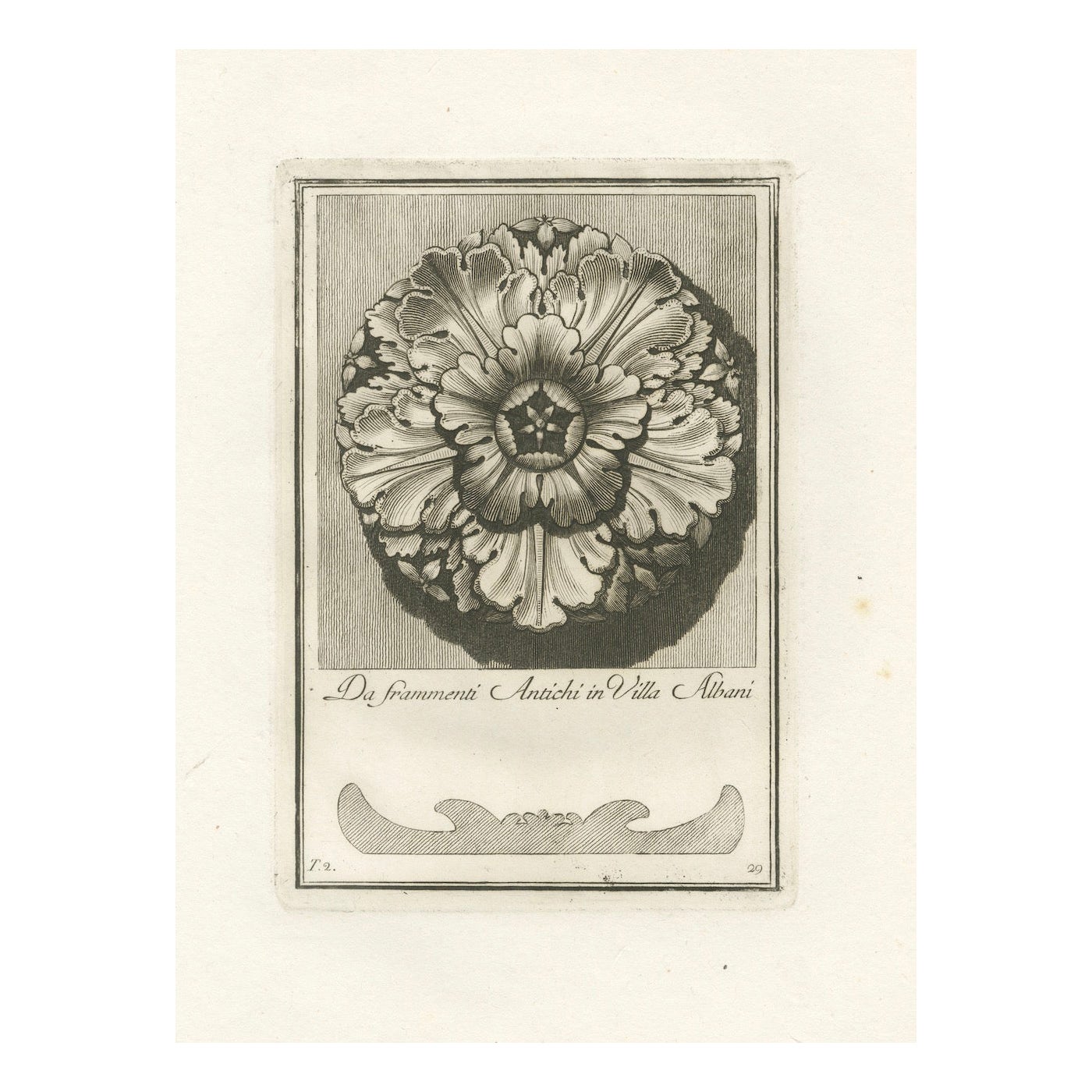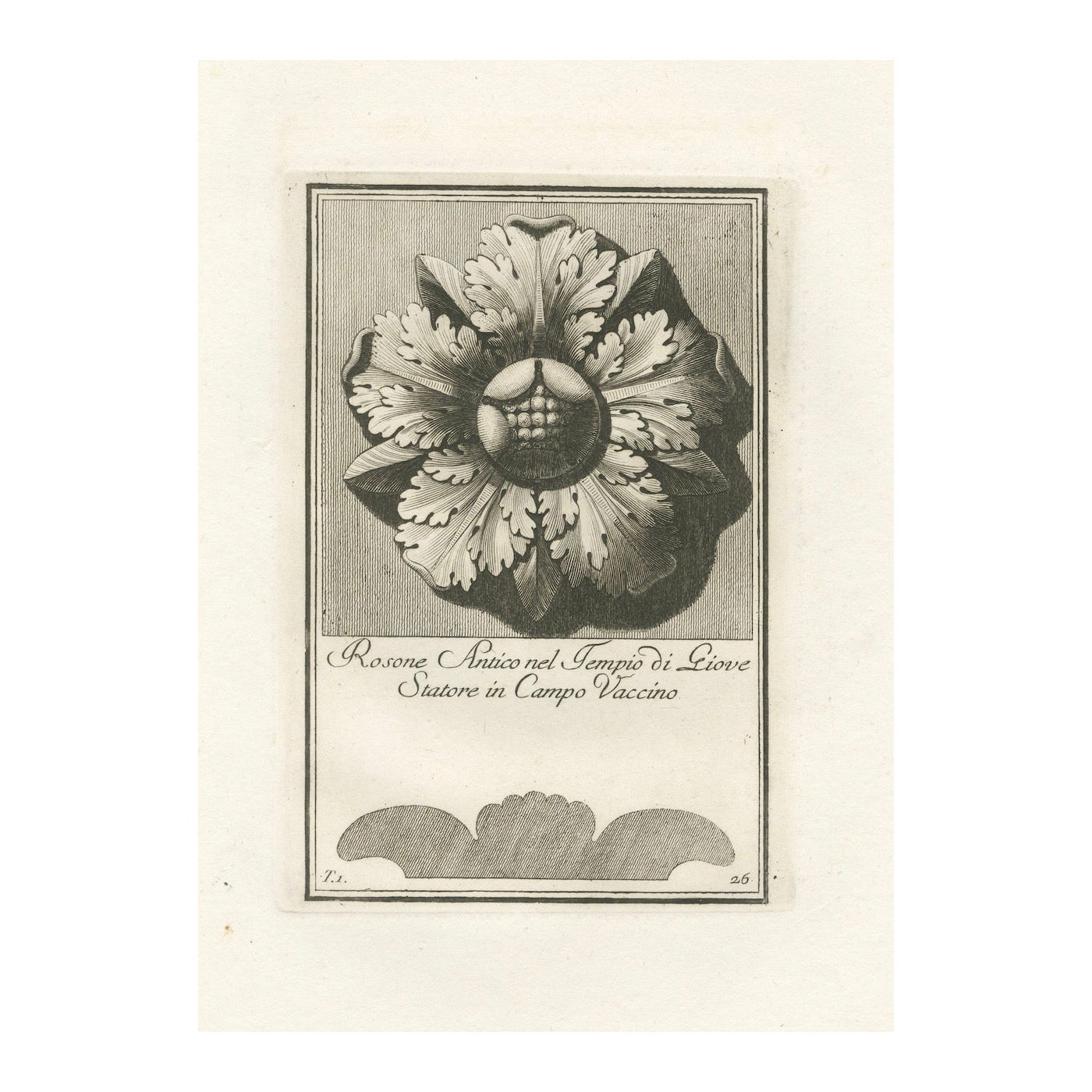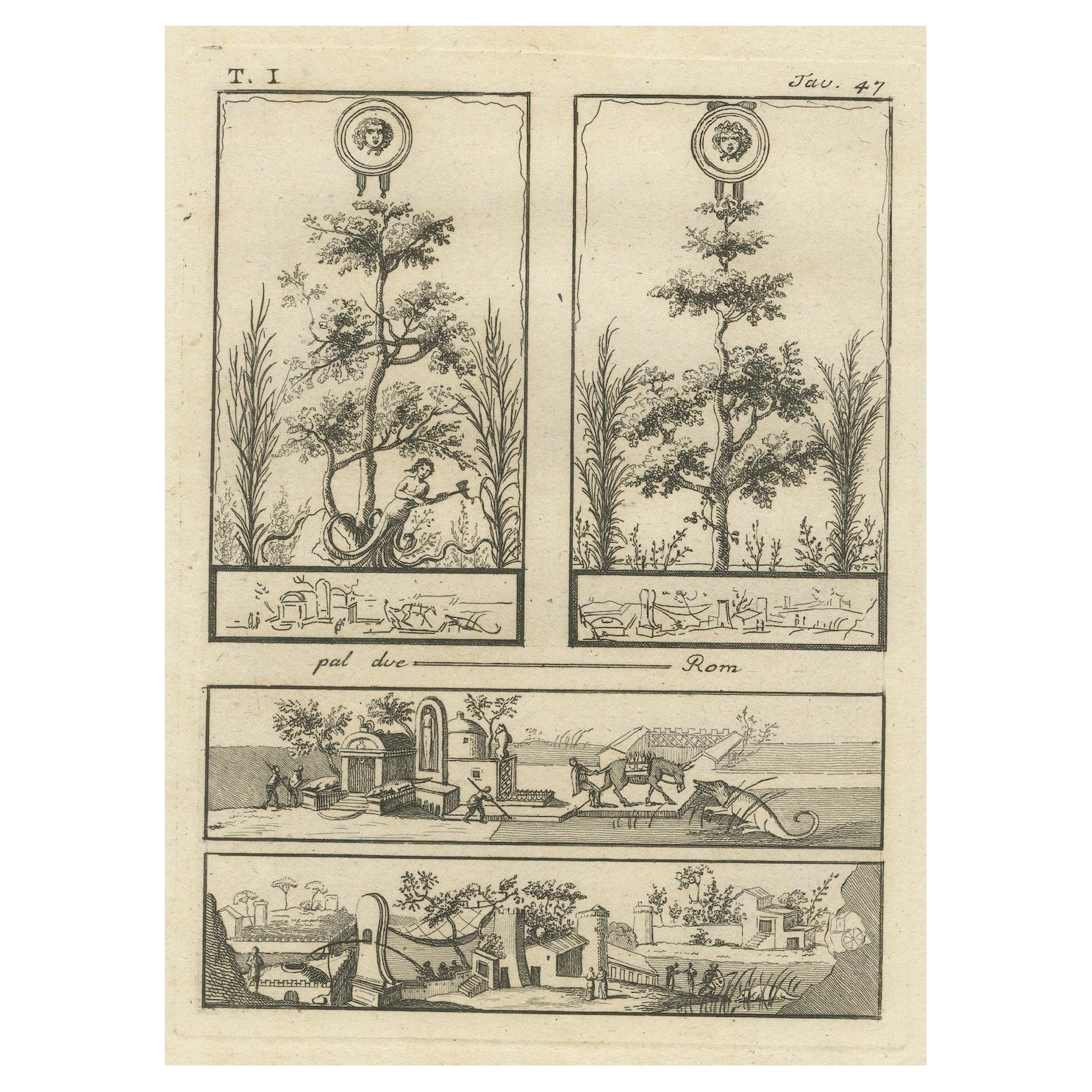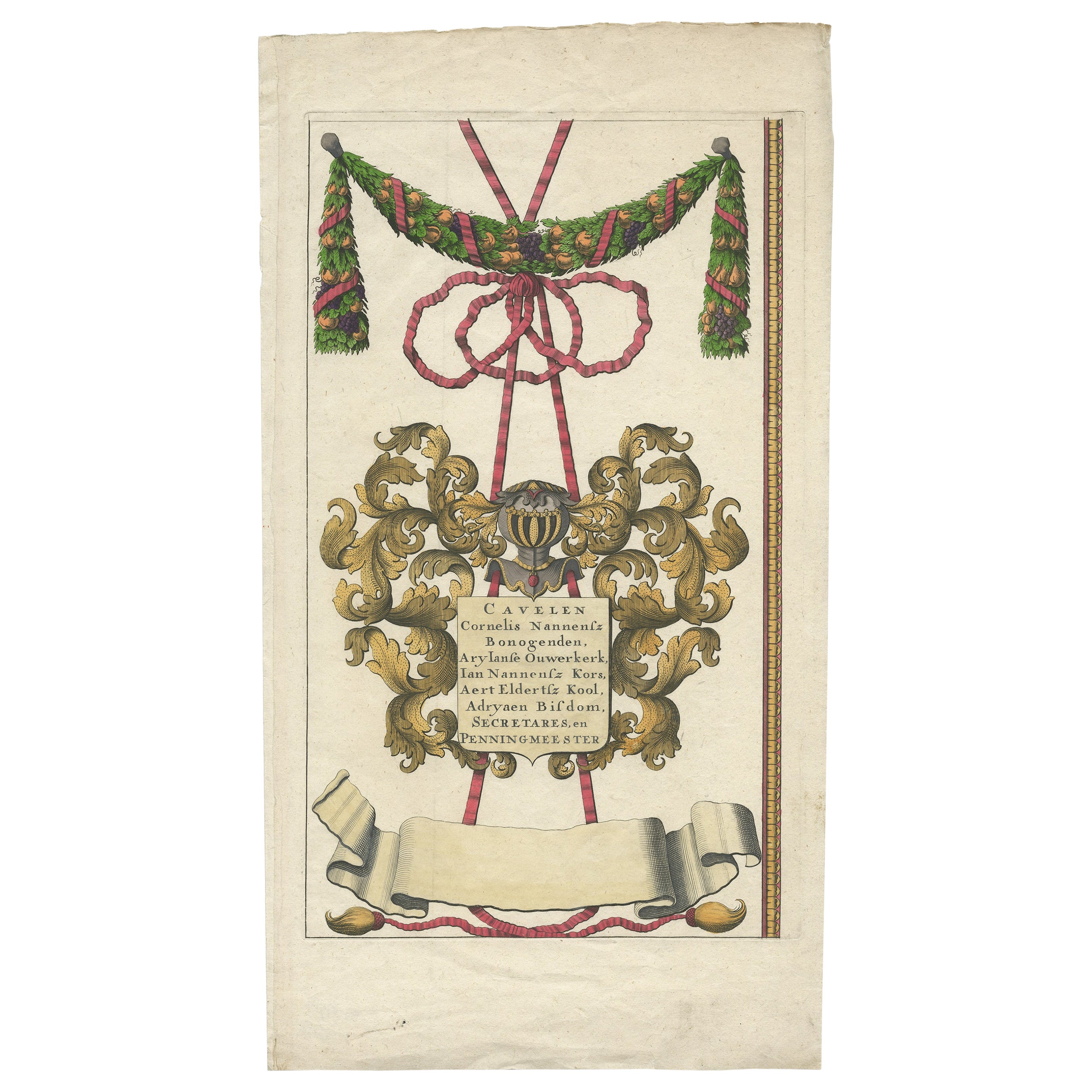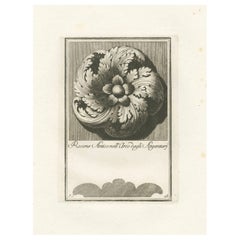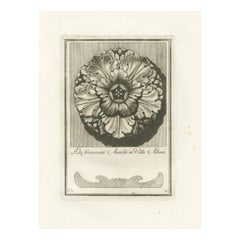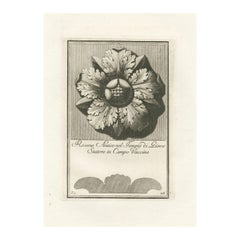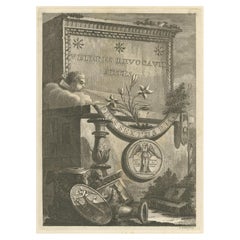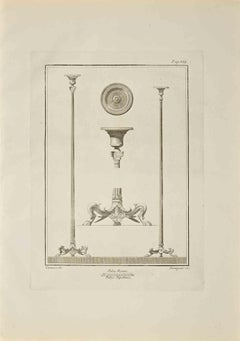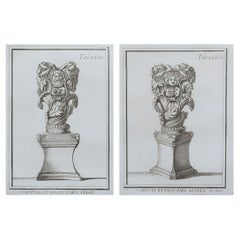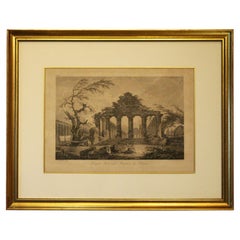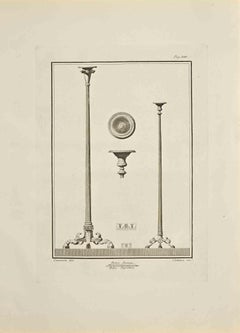Items Similar to Ancient Rosette in the Temple of Jupiter the Stayer, 1780
Want more images or videos?
Request additional images or videos from the seller
1 of 6
Ancient Rosette in the Temple of Jupiter the Stayer, 1780
$208.37
$260.4620% Off
£155.80
£194.7520% Off
€176
€22020% Off
CA$291.81
CA$364.7720% Off
A$320.82
A$401.0220% Off
CHF 165.84
CHF 207.2920% Off
MX$3,838.78
MX$4,798.4820% Off
NOK 2,093.63
NOK 2,617.0420% Off
SEK 1,962.84
SEK 2,453.5520% Off
DKK 1,340.76
DKK 1,675.9420% Off
About the Item
"Rosone Antico nel Tempio di Giove Statore."
A breakdown of the title:
- "Rosone" typically refers to an architectural term for a rose window, which is a circular window with a decorative design reminiscent of a rose. However, given that this is an illustration of a flower, "Rosone" here could possibly refer to the flower's resemblance to the stylized rosette patterns found in architecture.
- "Antico" means "ancient" or "antique" in Italian, suggesting historical significance or an object from the past.
- "nel Tempio di" translates to "in the temple of."
- "Giove Statore" refers to Jupiter Stator, a title of the god Jupiter in Roman mythology. The Temple of Jupiter Stator was a temple in ancient Rome, vowed by Romulus during the battle with the Sabines.
Combining these elements, the title could be interpreted as "Ancient Rosette in the Temple of Jupiter the Stayer." This could indicate that the flower depicted in the print is an artistic representation of an ornamental design found within or associated with the Temple of Jupiter Stator, or perhaps it is a poetic way to describe the flower's grandeur by likening it to something one might dedicate to a temple of Jupiter.
The print made by Carlo Antonini, active between 1777 and 1790, presents an intricate illustration of a floral design, which is labeled as "Rosone Antico nel Tempio di Giove Statore". The print is likely an engraving, a common practice of the time for producing detailed illustrations.
The floral design is highly stylized and symmetrical, typical of the decorative motifs one might find in classical architecture or ancient Roman decoration, which often took inspiration from the natural world and particularly flora. The term "Rosone" might refer to the flower's resemblance to the architectural rosette designs, which are patterned, circular, and ornate, similar to the detailed and layered petals shown in the engraving.
Given the period Carlo Antonini was active, the print would have been created using traditional engraving techniques, where a design was carved into a metal plate with a tool called a burin. After inking, the plate was used to press the image onto paper. This method allowed for fine lines and a high level of detail, as evidenced by the shading and the delicate lines that define the petals and the flower's center.
The inscription "nel Tempio di Giove Statore" suggests a connection to the Temple of Jupiter Stator in Rome, which was one of the ancient Roman temples dedicated to Jupiter as the stayer of flight in war, a protector in battle. This linkage in the title might imply that the design is either a historical representation from the temple, a dedication, or an artistic piece inspired by the motifs found in the temple.
Overall, the print would be characteristic of Antonini's work, reflecting both the aesthetic preferences of the time and the fascination with classical motifs and subjects that were prevalent in the art and culture of the 18th century.
- Dimensions:Height: 13.59 in (34.5 cm)Width: 8.78 in (22.3 cm)Depth: 0 in (0.02 mm)
- Materials and Techniques:Paper,Engraved
- Period:1780-1789
- Date of Manufacture:circa 1780
- Condition:Condition: good, given age. General age-related toning and/or occasional minor defects from handling. Please study scan carefully.
- Seller Location:Langweer, NL
- Reference Number:Seller: BG-13675-891stDibs: LU3054338333952
About the Seller
5.0
Recognized Seller
These prestigious sellers are industry leaders and represent the highest echelon for item quality and design.
Platinum Seller
Premium sellers with a 4.7+ rating and 24-hour response times
Established in 2009
1stDibs seller since 2017
2,683 sales on 1stDibs
Typical response time: <1 hour
- ShippingRetrieving quote...Shipping from: Langweer, Netherlands
- Return Policy
Authenticity Guarantee
In the unlikely event there’s an issue with an item’s authenticity, contact us within 1 year for a full refund. DetailsMoney-Back Guarantee
If your item is not as described, is damaged in transit, or does not arrive, contact us within 7 days for a full refund. Details24-Hour Cancellation
You have a 24-hour grace period in which to reconsider your purchase, with no questions asked.Vetted Professional Sellers
Our world-class sellers must adhere to strict standards for service and quality, maintaining the integrity of our listings.Price-Match Guarantee
If you find that a seller listed the same item for a lower price elsewhere, we’ll match it.Trusted Global Delivery
Our best-in-class carrier network provides specialized shipping options worldwide, including custom delivery.More From This Seller
View AllAncient Rosette in the Arch of the Silversmiths, 1780
Located in Langweer, NL
This original antique print is labeled "Rosone Antico nell'Arco degli Argentari," which can be translated as "Ancient Rosette in the Arch of the Silversmiths."
The phrase "Rosone An...
Category
Antique 1780s Prints
Materials
Paper
$208 Sale Price
20% Off
1780s Villa Albani-inspired Rosette Engraving
Located in Langweer, NL
This exquisite engraving, dating back to around 1780, presents a masterfully crafted rosette, a decorative motif that captures the elegance and refined aesthetic of the neoclassical ...
Category
Antique 1780s Prints
Materials
Paper
$208 Sale Price
20% Off
Original Antique Roman Rosette Engraving #26, Campo Vaccino
Located in Langweer, NL
This elegant engraving from the late 18th century features a rosette, an ornamental design resembling a stylized rose, which has been a recurring motif in architectural design throug...
Category
Antique 1780s Prints
Materials
Paper
$208 Sale Price
20% Off
Rare Antique Frontispiece of a Work about Ancient Chandeliers, 1781
Located in Langweer, NL
Antique frontispiece of volume 3 of 'Manuale di varj ornamenti tratti dalle fabbriche, e frammenti antichi' by Carlo Antonini. This work contains a seri...
Category
Antique 18th Century Prints
Materials
Paper
$132 Sale Price
20% Off
Roman Decorative Motifs and Architectural Scenes by Tommaso Piroli, 1789
Located in Langweer, NL
Roman Decorative Motifs and Architectural Scenes by Tommaso Piroli, 1789
This finely executed copperplate engraving by Tommaso Piroli (1750–1824) is part of his renowned series 'A...
Category
Antique 1780s Prints
Materials
Paper
Antique Engraving of a Coat of Arms, Originally Published in 1683
Located in Langweer, NL
Antique print titled 'Cavelen Cornelis Nannensz Bonogenden, Aryianse Ouwerkerk, Ian Nannensz Kors, Aert Eldertsz Kool, Adryaen Bisdom, Secretares en Penningmeester'. One of the coats of arms from the large wall map...
Category
Antique 19th Century Prints
Materials
Paper
$236 Sale Price
20% Off
You May Also Like
Ancient Roman Decorations - Etching G. Casanova - 18th Century
By Giacomo Casanova
Located in Roma, IT
Ancient Roman Decorations is an etching on paper realized by Giacomo Casanova in the 18th Century.
Signed on the plate.
Good conditions with some foxing and folding and a small c...
Category
Late 18th Century Old Masters Figurative Prints
Materials
Etching
Large Scale Original Antique Grand Tour Prints-Relief Carvings. Rome, 1776
Located in St Annes, Lancashire
Wonderful images of Relief Carvings
Copper-plate engravings
Published by Monaldini, Rome, 1776
Good quality wove paper
Free shipping
Category
Antique 1770s Italian Classical Roman Prints
Materials
Plaster
Late 18th Century French Print "Temple Herastyle Périptère de Pestum"
Located in Chapel Hill, NC
Late 18th century print "Temple Herastyle Périptère de Pestum", French. No 381, G.G., Gravé à L'eau-forte par Weisbret. Terminé par J. Miamet graveur du Roi. From "Voyage Pittoresque...
Category
Antique Late 18th Century French Neoclassical Prints
Materials
Paper
$396 Sale Price
20% Off
Ancient Roman Decorations - Etching G. Casanova - 18th Century
By Giacomo Casanova
Located in Roma, IT
Ancient Roman Decorations is an etching on paper realized by Giacomo Casanova in the 18th Century.
Signed on the plate.
Good conditions with some foxing and folding and a small c...
Category
Late 18th Century Old Masters Figurative Prints
Materials
Etching
Ancient Roman Fresco Herculaneum - Original Etching G. Casanova - 18th Century
By Giacomo Casanova
Located in Roma, IT
Ancient Roman Statues from the series "Antiquities of Herculaneum", is an original etching on paper realized by Casanova in the 18th Century.
Signed on the plate.
Good condit...
Category
Late 18th Century Old Masters Figurative Prints
Materials
Etching
The Ornament - Etching by Charles-Antoine Jombert - 1755
Located in Roma, IT
The Ornament is a woodcut print realized by Charles-Antoine Jombert in 1755.
Good conditions.
The print was realized for the anatomy study “JOMBERT, Charles-Antoine (1712-1784) - M...
Category
1750s Modern Figurative Prints
Materials
Etching
More Ways To Browse
Antique Grinding Stone
Antique Hand Carved Chinese Bar
Antique Keyhole Cover
Antique Korean Bandaji Chest
Antique Medical Art
Antique Merchant Chest
Antique Mounted Butterflies
Antique Patent
Antique Pine Server
Antique Postal Furniture
Antique Shaving Stand Furniture
Antique Smoking Set
Antique Solingen
Antique Stable Door
Antique Staffordshire Cows
Antique Stirrup Cup
Antique Teapoy
Antique Tool Chest
